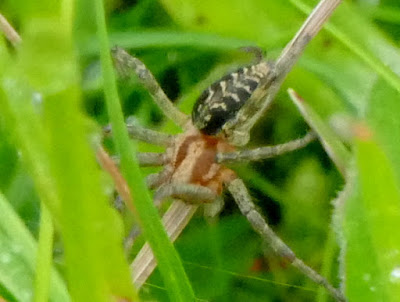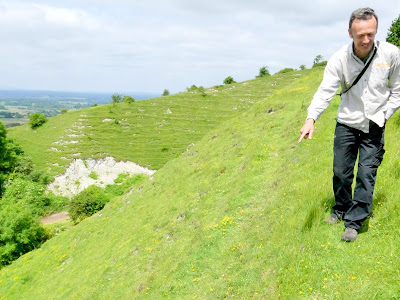We came here to photograph damselflies and dragonflies and got no pictures.
Marsh Harriers and a Kestrel made this a walk to remember though.
A male Marsh Harrier.
The larger female Marsh Harrier with a white head on the far side of the reserve.
These birds are a must to add to my natural history talk on birds: details at http://www.peterlovetttalks.co.uk/page17.html
Click on any picture to expand it.
For illustrated talks on natural history and history see www.peterlovetttalks.co.uk
For illustrated talks on natural history and history click here for www.peterlovetttalks.co.uk
Thursday, 30 June 2016
Saturday, 25 June 2016
Six Native Orchid species at this location this week: Bee, Common Spotted, Pyramidal, Frog,Southern Marsh and Fly Orchids
You can see my image reflected in the water film on this Bee orchid.
Thursday, 23 June 2016
Common Carder bee, Red-tailed Cuckoo bee, butterflies, a Burnet moth and the Labyrinth spider, Agelena labyrinthica yesterday in a Sussex meadow..
I came here yesterday to photograph Frog Orchids -- successfully. The insects were great too and are shown first. Six Orchid species to follow: Bee, Fly, Common Spotted, Southern Marsh, Pyramidal and Frog Orchids. It was a great day out.
Male Meadow Brown butterfly sharing a bramble flower with a male Fat-legged Flower beetle, Oedemera nobilis.
Here is a Labyrinth spider, Agelena labyrinthica.
See the excellent site http://www.uksafari.com/labyrinth.htm for more info'.
UK spiders are not harmful to most people and are really fascinating... at least to me.
An illustrated talk has been prepared. Details can be seen at http://www.peterlovetttalks.co.uk/page14.html
Click on any picture to expand it.
Common Carder bee on Yellow Rattle.
A Red-tailed Cuckoo Bee, Bombus rupestris with pollen beetles. It isn't collecting pollen. Why should it? It is a parasite of the Red-tailed Bee, Bombus lapidarius.
Six-spot Burnet moth, Zygaena filipendulae
Another Brown butterfly -- the Marbled White
A Spotted Crane Fly, Nephrotoma appindiculata
It was drizzling rain, which highlighted the webs of Funnel spiders beautifully.Here is a Labyrinth spider, Agelena labyrinthica.
See the excellent site http://www.uksafari.com/labyrinth.htm for more info'.
UK spiders are not harmful to most people and are really fascinating... at least to me.
An illustrated talk has been prepared. Details can be seen at http://www.peterlovetttalks.co.uk/page14.html
Click on any picture to expand it.
Tuesday, 21 June 2016
There is only one thing better than walking on the Sussex Downs... and that is to walk there with a National Trust Ranger.
National Trust Ranger, Graham Wellfare, lead a wonderful walk this afternoon from Saddlescoobe Farm over Newtimber Hill.
Where the path starts and where the cattle churn up the soil and flatten plants, Graham showed us the rarest plant on the Downs.
It is Centaurea calcitrapa known as the Red Star-thistle. A biennial herb of waste ground and tracksides in dry grassland, and on banks on well-drained sandy, gravelly or light chalky soils. Lowland. ref: http://www.brc.ac.uk/plantatlas/index.php?q=node/1522
It is an archaeophyte: a plant species which is non-native to a geographical region, but which was an introduced species in "ancient" times from the Mediterranean, rather than being a modern introduction. It doesn't appear in my books. The Romans or King Alfred (he traveled to Rome) may have inadvertently brought it here.
Where the path starts and where the cattle churn up the soil and flatten plants, Graham showed us the rarest plant on the Downs.
It is Centaurea calcitrapa known as the Red Star-thistle. A biennial herb of waste ground and tracksides in dry grassland, and on banks on well-drained sandy, gravelly or light chalky soils. Lowland. ref: http://www.brc.ac.uk/plantatlas/index.php?q=node/1522
It is an archaeophyte: a plant species which is non-native to a geographical region, but which was an introduced species in "ancient" times from the Mediterranean, rather than being a modern introduction. It doesn't appear in my books. The Romans or King Alfred (he traveled to Rome) may have inadvertently brought it here.
Graham pointed out the diversity of plants where the ground had not been ploughed or fertilized.
Click on any picture to expand it.
It was the orchids that stole the show -- Fragrant, Common Spotted, Pyramidal and Twayblades.
Keep an eye on http://www.nationaltrust.org.uk/saddlescombe-farm-and-newtimber-hill for future National Trust events. Alternatively, clubs and societies interested to see the Pride of Sussex, the County Flower of Sussex on a lead walk by me could take a look at http://www.peterlovettwalks.eu/
In any case, enjoy our beautiful Sussex countryside this summer.
Sunday, 19 June 2016
Orchid walk and talk with the National Trust
The National Trust invite you to enjoy an illustrated talk by orchid expert, Peter Lovett, followed by a walk on glorious Newtimber Hill with ranger Graham Wellfare looking for these beautiful flowers.
When: Tuesday 21st June
Where: Saddlescombe farm. BN45 7DE.
Time: 10am – 2pm.
Cost £10
Booking is essential
Peter Lovett is a keen nature lover and public speaker. Get an insight to his talk at http://www.
Call Graham on 01273 857712 to book. Details are also at http://www.nationaltrust.
Press release issued jointly by;
Graham Wellfare
National Trust Ranger
Saddlescombe Farm
BN45 7DE
tel 01273 857712
Peter Lovett
tel 01444 415367
Tuesday, 14 June 2016
Three Queen Bumblebees and soaked workers in a Sussex garden yesterday
Styrax japonica is a colouful small tree, which although not native to the UK, is great for bees.
THREE bumblebee species' queens were active yesterday evening.
A Buff-tailed Bumblebee queen, Bombus terrestris.
A White-tailed Bumblebee queen, Bombus lucorum
And a Red-tailed Bumblebee queen, Bombus lapidarius
Some bees were struggling to survive the downpour of rain.
This Buff-tailed Bumblebee worker or male is drenched to the chitin.
Elsewhere in the garden other species were active.
This Early Bumblebee male, Bombus pratorum was very happy on cornflowers.
What a joy to see all these species thriving in a formal and wildlife garden
Click on any picture to expand it.
THREE bumblebee species' queens were active yesterday evening.
A Buff-tailed Bumblebee queen, Bombus terrestris.
A White-tailed Bumblebee queen, Bombus lucorum
And a Red-tailed Bumblebee queen, Bombus lapidarius
Some bees were struggling to survive the downpour of rain.
This Buff-tailed Bumblebee worker or male is drenched to the chitin.
Elsewhere in the garden other species were active.
This Early Bumblebee male, Bombus pratorum was very happy on cornflowers.
What a joy to see all these species thriving in a formal and wildlife garden
Click on any picture to expand it.
Sunday, 12 June 2016
11th June 2016, Red-tailed Bumblebee, male Bombus lapidarius "stealing" nectar from Aquilegia
This Red-tailed Bumblebee male, Bombus lapidarius' tongue is too short to reach into the Aquilegia flowers' long spurs. It "steals" nectar by cutting into the blind end of the spur, missing the pollen completely and playing no part in pollination of the flowers.
Subscribe to:
Comments (Atom)
Blog Archive
-
▼
2016
(86)
-
▼
June
(13)
- Mash Harriers at Stodmarsh National Nature Reserve...
- Six Native Orchid species at this location this we...
- Common Carder bee, Red-tailed Cuckoo bee, butterfl...
- There is only one thing better than walking on the...
- Orchid walk and talk with the National Trust
- Three Queen Bumblebees and soaked workers in a Su...
- 11th June 2016, Red-tailed Bumblebee, male Bombus ...
- Subterfuge and camouflage in nature: a bee-look-al...
- Love is blooming on buttercups, or do my manly thi...
- Bumblebees; Common Carder bee, Forest cuckoo bee a...
- Flowers on the Sussex Downs including native orchi...
- Native orchids on the South Downs today: Burnt Orc...
- Marsh frogs at the Dutch National park De Groote P...
-
▼
June
(13)



















































